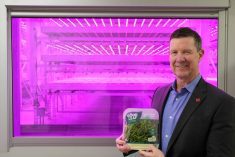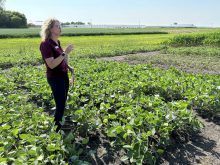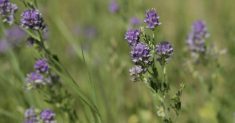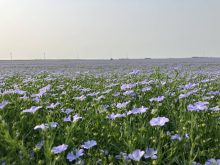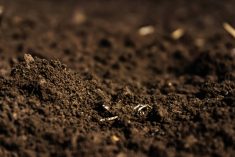Growers manage fertility and soil health with less tractor hours by growing perennial forage seed crops
Growing organic forage seed takes a different mindset.
Larry Pollock, who has been farming organically since the 1990s on 600 acres north of Brandon, was part of a panel of experienced growers offering insights at a recent workshop hosted by Manitoba Agriculture, Food and Rural Initiatives.
He sows 100 to 150 acres of alfalfa under contract with a seed company from May to June with no nurse crop, and clips the fields at least four times during the first summer of establishment with an 18-foot swather to control weeds before they go to seed.
Read Also

Manitoba sclerotinia picture mixed for 2025
Variations in weather and crop development in this year’s Manitoba canola fields make blanket sclerotinia outlooks hard to pin down
Pollock’s seeding rate ranges from 5.5 to 13 pounds per acre and is put in with “Gizmo,” a specialized zero-till drill with six-inch row spacing that he built himself.
“I like to sow a new field of alfalfa every year, so we’ve got another field to break up just to keep ahead of the bugs,” said Pollock, who grows spelt as the other half of his rotation.
“It seems to take a year for the bugs to find it and pollute it.”
The following year, he puts leafcutter bees on to half of the fields, a decision based on which fields have the least lygus bugs and weevil infestations. Particularly bad areas are usually cut and baled by a neighbour.
He advises organic seed producers faced with massive infestations of bugs not to panic.
Once, in early July, a field was so infested with alfalfa weevils that the crop turned grey and looked like it is going to die. Test sweeps with a net found “handfuls” of bugs, well in excess of the economic threshold. But along with the bad bugs, he found lots of good ones, too.
He went away to a meeting for a couple of days, then came back to find that the bugs were gone and the crop recovering. Pollock put the bees out — at a rate of 35,000 bees per acre — and told the neighbour to keep his swather and baler at home. In the fall, he harvested 500 pounds of seed per acre of the field.
“Mother Nature’s predators will catch up provided you have enough moisture,” said his wife Pat.
Average alfalfa seed yields in Manitoba are 220 pounds per acre, but Pollock has harvested as much 500 pounds per acre. Sometimes the crop is so heavy and tall it takes three combines three days to do 60 acres, he added.
Bison weed control
John Finnie, who farms 1,000 acres near Kenton, uses his 100-head bison herd as a tool to manage perennial weeds in his organic red clover seed fields. He chose forage seed production as a way to manage fertility and move away from tillage.
“They love sow thistle and dandelions, but they don’t like Canada thistle,” said Finnie, adding that clipping his clover in the second week of June helped control Canada thistle.
Adjusting the combine is tricky, he said. Also, his seed-cleaning facility is not perfect, so he markets his seed mainly to neighbours. Yields from red clover average 125 to 150 pounds per acre, compared to 220 under conventional production on his land.
Jeremiah Evans, who farms near Somerset, has grown red and yellow clover for seed with the goal of making some cash while improving his soil.
Even though weeds and a late start in putting bees on saw his first attempt at red clover go awry, yields on poor, hilly, shale land averaged 100 pounds per acre in the second year. After it was plowed under, the land that previously only yielded five to 10 bushels of wheat per acre jumped to 20, with 18 per cent protein.
“I took a sample to the elevator and they had never seen that before,” said Evans.
Wayne James grows red clover, timothy and tall fescue on his organic farm near Beausejour. He broadcasts forage seed along with a nurse crop, such as flax, at a rate of three pounds per acre and then harrows it in. For alfalfa, he mixes one pound per acre with another crop in his seed drill.
“We’ve always gotten a good catch with that,” said James, who doesn’t own an air seeder.
In year one, he underseeds alfalfa with flax. The next spring, he uses a press drill to put timothy into the alfalfa, which is harvested for seed that fall. In the third year, the timothy hadn’t come through enough, so he took a second harvest of alfalfa seed.
“In the fourth year, the timothy came through to the point where I was able to get 250 pounds per acre of timothy,” he said. In the succeeding three years, he continued harvesting the timothy until yields dropped to 175 pounds per acre.
“What I’m really looking for is any reason to not go out with the tractor and work down the land,” said James.






